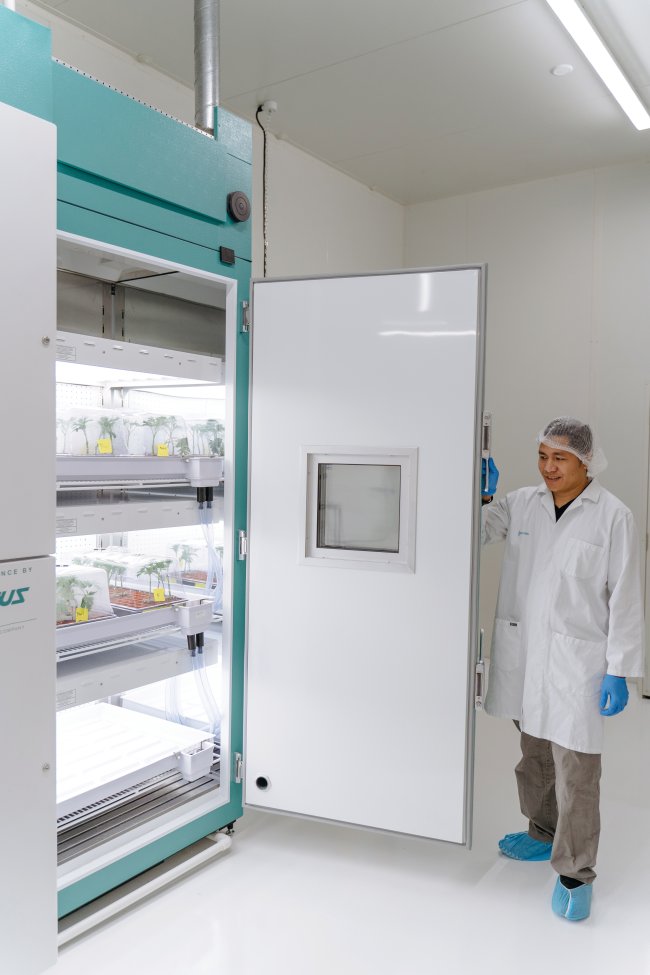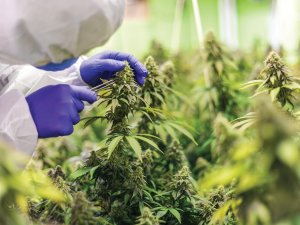Respiratory physician Lutz Beckert considers chronic obstructive pulmonary disease management, including the prevention of COPD, the importance of smoking cessation and pulmonary rehabilitation, and the lifesaving potential of addressing treatable traits. He also discusses the logic of inhaler therapy, moving from single therapy to dual and triple therapy when indicated, as well as other aspects of management
Pain relief from a secure joint: Behind the gates at Helius Therapeutics
Pain relief from a secure joint: Behind the gates at Helius Therapeutics

Kia ora, please enjoy our Summer Hiatus selection of stories and comment from throughout 2023, curated by our editorial team. This article was first published on 8 November. We will be back from our summer break on 15 January. Happy reading
Chosen by Zach: A fascinating visit to this facility resulted in my favourite story of the year. A really interesting sector to look into and a privilege to be invited inside Helius Therapeutics
My first sight of Helius Therapeutics is a tall metal fence; a white building, part industrial warehouse, part super-secret spy facility, sits beyond it. No Aston Martins in the car park, though – I checked.
The East Tāmaki facility is 8800sqm, making it roughly the size of two rugby fields, and “HELIUS” signage is proudly displayed out front.
I don’t know if the fence is electric, but the place is giving off a Jurassic Park feel so I’m not taking any chances touching it.
A security person (at least I assume he is, he’s wearing high-vis) greets me and checks my name is on the list.
Once inside, I’m given a white sticker with my name on it, ushered up a staircase and led into a boardroom where about 20 doctors and pharmacists wait to find out the secrets of the universe, or at least, how cannabis can help to treat pain.
Guest speaker Michael Murphy, clinical director of medicinal cannabis clinic CannaPlus+, gives a short presentation on the history of cannabis and the latest research on its medicinal qualities.
While morphine (extracted from opioids) and cocaine were used for medicinal purposes throughout the late 19th and into the 20th century, cannabidiol was only isolated in 1940 and it wasn’t until 1964 that tetrahydrocannabinol was separated from cannabis, Dr Murphy says.
It took another 23 years before the discovery of the endocannabinoid system, an “essential, complex [and] dynamic” 500-million-year-old, internal homeostatic system, present in every animal with a spine, he says.
This ultimately led to research into how each component of the cannabis plant can be used to treat different ailments.
Dr Murphy says countries such as Australia collect data on which products are being used to treat various conditions. Such data collection is not done in New Zealand but putting it in place would help develop local research, he says.
Citing the New Zealand Drug Foundation’s State of the Nation 2020 report, Dr Murphy says 4.5 per cent of adult Kiwis use cannabis at least weekly (approximately 250,000 people); this figure is close to the number of anti-depressant prescriptions nationwide.
The report suggests 42 per cent of survey respondents who used cannabis did so for medicinal purposes but just 6 per cent of them had a prescription for a legal form of it.
Following the presentation, it’s time to see how Helius makes its medicinal cannabis products.
Helius cannot disclose the details of its products to the general public as per its agreement with the Ministry of Health but it can show visitors the process.
Gowns and shoe covers are compulsory, as well as hair nets (ironic given I’m mere days from a haircut appointment and had to spend a good five minutes tucking in every last strand).
We’re guided around in groups through air-locked rooms and shown how Helius grows and manufactures cannabis, including a visit to a purpose-built room for removing ethanol and another where light exposure is controlled to help the plants grow.
Such is the science-fiction feel of the place in some parts, and with AI so top of mind these days, walking through the corridors and key-carded doors, I found myself wondering if all the staff were human or if there was an android among us.
The company is only five years old and has a team comprising just 27 people, Helius chief executive Carmen Doran tells New Zealand Doctor Rata Aotearoa.
“It’s really exciting to be building not just a new company but [to be involved in] a whole new industry for New Zealand in an area that we can be world leaders in,” Ms Doran says.
Aotearoa hasn’t previously had a significant pharmaceutical industry and “this is our time to shine”, she says.
New Zealand’s medicinal cannabis market is demonstrating “fantastically strong” growth, ahead of the company’s predictions, Ms Doran says.
MedSafe data obtained by Helius under the Official Information Act shows more than 60,000 packs of products containing medicinal cannabis were sold in New Zealand in 2022.
MedSafe says this figure only reflects packs and does not account for the number of prescriptions, patients or doses.
Additionally, the data is indicative of unapproved medications so does not include products with consent to be distributed as medicines, specifically Sativex and Epidyolex.
Doctors and patients are starting to reduce the stigma associated with the drug, Ms Doran says. The company is keen to educate doctors to encourage them to feel comfortable to prescribe treatments of this kind.
Regulatory changes are expected to make it easier for Helius to export its products, allowing the company to grow internationally and establish more options for its Kiwi patients, says Ms Doran.
Asked just after last month’s general election whether the poll would affect Helius or the wider medicinal cannabis industry, she says various MPs had visited the facility and many parties recognised the industry’s value.
“We’re proud to be supplying New Zealand-grown, New Zealand-made products for our [local] patients.
“I’m really excited about being able to offer better, more effective dosage forms for specific treatments in future but also wrapping the data and the science around that to bring doctors along on the journey,” Ms Doran says.









![Barbara Fountain, editor of New Zealand Doctor Rata Aotearoa, and Paul Hutchison, GP and senior medical clinician at Tāmaki Health [Image: Simon Maude]](/sites/default/files/styles/thumbnail_cropped_100/public/2025-03/Barbara%20Fountain%2C%20editor%20of%20New%20Zealand%20Doctor%20Rata%20Aotearoa%2C%20and%20Paul%20Hutchison%2C%20GP%20and%20senior%20medical%20clinician%20at%20T%C4%81maki%20Health%20CR%20Simon%20Maude.jpg?itok=-HbQ1EYA)
![Lori Peters, NP and advanced health improvement practitioner at Mahitahi Hauora, and Jasper Nacilla, NP at The Terrace Medical Centre in Wellington [Image: Simon Maude]](/sites/default/files/styles/thumbnail_cropped_100/public/2025-03/2.%20Lori%20Peters%2C%20NP%20and%20advanced%20HIP%20at%20Mahitahi%20Hauora%2C%20and%20Jasper%20Nacilla%2C%20NP%20at%20The%20Terrace%20Medical%20Centre%20in%20Wellington%20CR%20Simon%20Maude.jpg?itok=sUfbsSF1)
![Ministry of Social Development health and disability coordinator Liz Williams, regional health advisors Mary Mojel and Larah Takarangi, and health and disability coordinators Rebecca Staunton and Myint Than Htut [Image: Simon Maude]](/sites/default/files/styles/thumbnail_cropped_100/public/2025-03/3.%20Ministry%20of%20Social%20Development%27s%20Liz%20Williams%2C%20Mary%20Mojel%2C%20Larah%20Takarangi%2C%20Rebecca%20Staunton%20and%20Myint%20Than%20Htut%20CR%20Simon%20Maude.jpg?itok=9ceOujzC)
![Locum GP Helen Fisher, with Te Kuiti Medical Centre NP Bridget Woodney [Image: Simon Maude]](/sites/default/files/styles/thumbnail_cropped_100/public/2025-03/4.%20Locum%20GP%20Helen%20Fisher%2C%20with%20Te%20Kuiti%20Medical%20Centre%20NP%20Bridget%20Woodney%20CR%20Simon%20Maude.jpg?itok=TJeODetm)
![Ruby Faulkner, GPEP2, with David Small, GPEP3 from The Doctors Greenmeadows in Napier [Image: Simon Maude]](/sites/default/files/styles/thumbnail_cropped_100/public/2025-03/5.%20Ruby%20Faulkner%2C%20GPEP2%2C%20with%20David%20Small%2C%20GPEP3%20from%20The%20Doctors%20Greenmeadows%20in%20Napier%20CR%20Simon%20Maude.jpg?itok=B0u4wsIs)
![Rochelle Langton and Libby Thomas, marketing advisors at the Medical Protection Society [Image: Simon Maude]](/sites/default/files/styles/thumbnail_cropped_100/public/2025-03/6.%20Rochelle%20Langton%20and%20Libby%20Thomas%2C%20marketing%20advisors%20at%20the%20Medical%20Protection%20Society%20CR%20Simon%20Maude.jpg?itok=r52_Cf74)
![Specialist GP Lucy Gibberd, medical advisor at MPS, and Zara Bolam, urgent-care specialist at The Nest Health Centre in Inglewood [Image: Simon Maude]](/sites/default/files/styles/thumbnail_cropped_100/public/2025-03/7.%20Specialist%20GP%20Lucy%20Gibberd%2C%20medical%20advisor%20at%20MPS%2C%20and%20Zara%20Bolam%2C%20urgent-care%20specialist%20at%20The%20Nest%20Health%20Centre%20in%20Inglewood%20CR%20Simon%20Maude.jpg?itok=z8eVoBU3)
![Olivia Blackmore and Trudee Sharp, NPs at Gore Health Centre, and Gaylene Hastie, NP at Queenstown Medical Centre [Image: Simon Maude]](/sites/default/files/styles/thumbnail_cropped_100/public/2025-03/8.%20Olivia%20Blackmore%20and%20Trudee%20Sharp%2C%20NPs%20at%20Gore%20Health%20Centre%2C%20and%20Gaylene%20Hastie%2C%20NP%20at%20Queenstown%20Medical%20Centre%20CR%20Simon%20Maude.jpg?itok=Z6u9d0XH)
![Mary Toloa, specialist GP at Porirua and Union Community Health Service in Wellington, Mara Coler, clinical pharmacist at Tū Ora Compass Health, and Bhavna Mistry, specialist GP at Porirua and Union Community Health Service [Image: Simon Maude]](/sites/default/files/styles/thumbnail_cropped_100/public/2025-03/9.%20Mary%20Toloa%2C%20Porirua%20and%20Union%20Community%20Health%20Service%20in%20Wellington%2C%20Mara%20Coler%2C%20T%C5%AB%20Ora%20Compass%20Health%2C%20and%20Bhavna%20Mistry%2C%20PUCHS%20CR%20Simon%20Maude.jpg?itok=kpChr0cc)